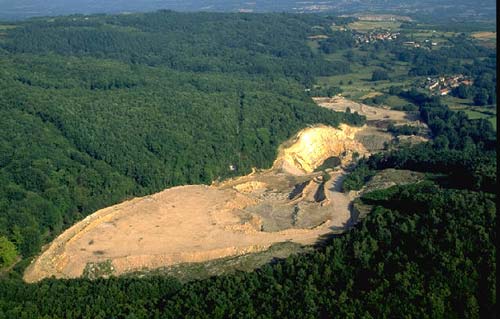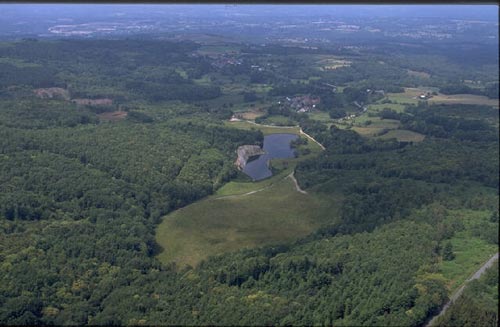Waste from uranium extraction
The residues from processing uranium ores are disposed of on the sites of the mines. This mining waste is very low-level waste because uranium, which is very long-lived (it can last for several billion years), is one of the least radioactive elements in nature and the uranium content of uranium-bearing ores is generally low.
This low content means that vast quantities of rock have to be processed. The rock is crushed on site. Once the uranium has been removed, the mining residues contain radioactive elements that are the descendants of uranium, which are radioactively stable. The radioactivity of these residues accounts for around 80% of the original natural radioactivity of the rock. All the descendants remain contained in the soil, except the radon gas.

Uranium mine in Limousin
Uranium mines in France are running out and mining ther is no longer economically viable. The closure of mines is followed by restauration of the site. View in 1993 of the open-cast uranium mine at Puy de l’Âge, near La Crouzille in Limousin, before restauration.
© AREVA/Jean-Marie Taillat
Mining does not create new radioactivity but brings to the surface the natural radioactivity in uranium-bearing rocks. Despite the concentration due to this process, the radioactivity remains low: a few thousand becquerels (Bq ) per kilo. By way of comparison, the radioactivity of the human body is 8000 becquerels.
) per kilo. By way of comparison, the radioactivity of the human body is 8000 becquerels.
French uranium mines have been closed, but 50 million cubic metres of mining residues have been produced in France. Disposal on site is the only practical solution. When a site is redeveloped, the residues are covered by a layer of waste rock to prevent them from being dispersed by erosion. This covering also acts as a barrier to prevent the emission of gamma radiation, the release of radon, and the inhalation of dust.
Without the protection provided by this covering, the dose rate in the open air at the site of the mining residues would be around a hundredth of a millisievert (mSv ) per hour, which means that it would take more than ten days’ exposure to receive a dose of 2.4 mSv, the equivalent of our annual exposure to natural radioactivity. With the covering the doses are much lower.
) per hour, which means that it would take more than ten days’ exposure to receive a dose of 2.4 mSv, the equivalent of our annual exposure to natural radioactivity. With the covering the doses are much lower.

Uranium mine site after restauration
Aerial view on 23 June 1997 of the former open-cast uranium mine at Puy de l’Âge, near La Crouzille in Limousin, during restaurations. The residues have been covered by a layer of waste rock to prevent them from being dispersed by erosion. Studies show that one metre of a clay covering prevents practically all of the radon migration. Nature has taken over again. Part of the site has been returned to agriculture and forestry, another part has been developed as a lake.
© Jean-Marie Taillat
In 2003 a very popular French radio station spoke on air to a listener complaining that she was suffering from thyroid cancer, which she attributed to having walked on the site of a disused uranium mine. Thyroid cancers observed at Chernobyl were caused by the dispersal of a radioactive isotope of iodine, iodine-131, but there is no mechanism that produces iode-131 at a uranium mine.
The listener could have complained more plausibly about radon emanations, which can cause lung cancer. But the risks presented by these emanations while walking outdoors are too low for cancer to be attributed to them years later. The reputation of uranium mines comes from the fact that years ago miners worked in poorly ventilated, dusty mine shafts.
This pollution risk on the site of former mines is more chemical than radioactive. In all uranium mines there are heavy metals present that are toxic but not particularly soluble, such as lead. It is necessary to check for the presence of these heavy elements in streams and rivers, and to cover the site to prevent the inhalation of dust containing them.
Other articles on the subject « Waste Inventory »
Recoverable materials
Inventory of reusable uranium and plutonium stocks The radioactive species present in the spent f[...]
France: waste panorama (1)
An overview of French waste categories… In France, radioactive waste is split into five cat[...]
France: waste panorama (2)
An overview of French waste categories (continued)… Low- and intermediate-level short-lived[...]
US panorama
The case of the greatest nuclear power Nuclear-powered US Navy vessels, past production of nuclea[...]
Various radioactive waste
Radioactive waste from many different sources… When radioactive waste is mentioned, people [...]
Medicine and research
Radioactive sources, producers of waste outside the nuclear industry… Biology labora[...]
Military waste
A separate system Using the gaseous diffusion process, the AREVA Pierrelatte facility produced en[...]
Radium-bearing waste
Legacy waste – weakly radioactive but long-lived Recent and less recent industrial activities hav[...]
Waste from Dismantling
Dismantling of facilities: graphite waste Experience with dismantling nuclear power plants is onl[...]
Waste from Industry
Obsolete radioactive sources, the legacy of radium applications There are numerous industrial app[...]